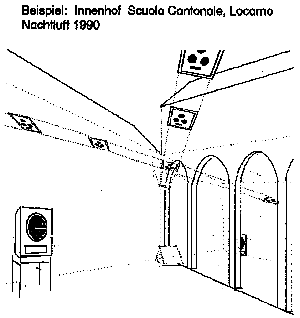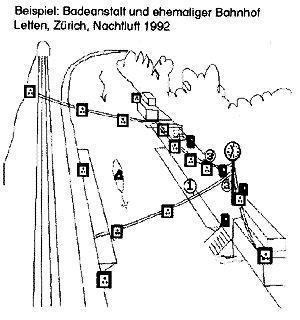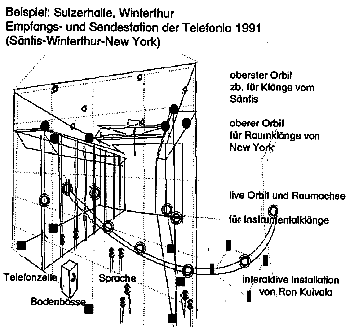ANDRES BOSSHARD
SONIC SPACE ARCHITECTURE II
2nd voice: TIME (describing)
i usually have to set up my mostly d-i-y equipment on one or two tables and connect it to the mains power supply.
i can't really call this array one machine. new components are always being added and the whole system is in a constant state of modification. just a  few changes to the way the individual components are connected together, and you often have a completely new instrument. development work began over ten years ago with the so-called cassette machinery. that was a kind of sampler, with by far the cheapest form of memory, although accessing the required sounds did require a considerable degree of digital dexterity.
few changes to the way the individual components are connected together, and you often have a completely new instrument. development work began over ten years ago with the so-called cassette machinery. that was a kind of sampler, with by far the cheapest form of memory, although accessing the required sounds did require a considerable degree of digital dexterity.
although the equipment has a strong presence, most of what happens is concealed and be-yond our direct powers of perception.
that is also the reason why the most important item, the matrix mixer, is made of clear plexiglas, so as to offer insights (or even throughsights).
elasticity and transparency are not the kind of property normally found in machines, and it is not just a question of surfaces; the matrix mixer has been built above all to permit sounds to emerge simultaneously, or quasi simultaneously, at as many locations as possible.
1
it permits several sounds to be handled in space independ-ently of each other, although it is not so much the electronics but the location of the speakers in the space that is important .
the distance between the individual speakers is sonic time, which determines the temporal depth of spatial sound. every space will support quite different constellations, contains specific nodes where speakers are specially effective. to find them i need time to explore the space, to listen. the best points are rarely located along the walls, or in the corners, but quite literally in the air.
with the help of cables i manage relatively quickly to mount the speakers in almost any position and adjust them.
vertical or horizontal spatial axes produce their own specific dynamism. especially the vertical dimension of sound has surprising qualities, and they have rarely been the subject of musicological research.
spatial axes are not only the key to the immediate acoustic space; they also stimulate acoustic flights pointing beyond the here and now. these spatial perspectives open up in a flash and seem to give extension to the sounds or even to change their aggregate condition.
a number of superimposed rings also serve to create sound horizons, permitting sonic interaction between several spaces.
 the configuration of the speakers in the space creates the basis for the spatial properties of the sounds. electromagnetic access at various points within the space opens up a potential for a temporal geometry capable of creating space.
the configuration of the speakers in the space creates the basis for the spatial properties of the sounds. electromagnetic access at various points within the space opens up a potential for a temporal geometry capable of creating space.
spatial sound can only be perceived as you move around.
from one static point of hearing the temporal perspectives seem linear and fixed. al-though sounds can be located, their depth in time is not revealed. in a twin-track recording the spatial intervals between the individual sound sources are fixed once and for all. the sounding sound space seems to be located "behind" the speakers, while the "audience" sits "in front of" the sound. the temporal geometry of the modern media stage is flat.
unfortunately most live concerts are equally "mixed", and the spatial depth of the music practically obliterated.
2
reproduction via a number of speakers distributed in the space, however, is only meaningful if each speaker can be controlled separately. that is where the matrix mixer comes in. (a matrix sets up a relational pattern between each and every point.)
that means i can first direct all my sounds to a small speaker right up at the back of the space and then begin to let the various sound strata disperse in various directions all at the same time, so that you finally have a different sound from every speaker.
this movement can be experienced as the opening up of the space. not only the sounds them-selves can be heard, but also the intervals. where a sound is itself composed of several sound strata, the sound opens up in this spatial movement and lets us hear within the sound.
the temporal depth that the sound can reveal depends on the spatial - and therefore temporal - distance between the individual speakers that are the vehicle of this spatial sound.

as this kind of sound in space is dependent on the running times between the individual sound components, it is very meaningful to influence the temporal structure electronically. the delay array can assign a separate, independent and easily modifiable delay to six different channels.
3
by influencing the temporal structure of a sound in space, i gain new scope for sonic design. not only can sounds be relocated in the space and their extension increased; they can also be positioned outside of the real sound space. the delay array can delay a signal by a maximum 1.2s. that makes it possible to conjure up a sound space with a diameter of up to 500m.
parallel to these temporal geometries, the more familiar electronic "effects" also take on new and unheard of potential. for example, on the opposite side of the space, the reverberation component of a sound can move in the opposite direction to the original sound. that can be experienced as a reversal of the whole of the acoustic space.
with the combination of the matrix mixer, delay array and effects devices, i can locate and move three sound levels in three individual spatial zones. in this multiple space, real acoustic and virtual electronic components interact on equal terms.
i am interested in this dynamic sound space not only as a form of "electronic sculpture", but also as an instrument to explore spaces with greater temporal depth. that is to say, for me navigation in time and space means not only the spatial-temporal articulation of sounds within a certain space but also permanent synchronization with the whole of the acoustic and media space in the world around us.
the equipment in front of me has not only its own potential in terms of time and space but also the potential to offer audible and experienceable access to the electronic spaces, and to do so publicly and in principle permanently.
4
it should now be clear that these tools can also be a model for all electronic media. that is why it is also possible to include light sensors, movement detectors, wind sensors and so on, and to employ the data inputs from them not only to modulate sounds but also to transmit them to motors, electro-magnets, pneumatic systems, valves etc. whether these items are located in the same space or are located elsewhere on earth, or even in near space, suddenly seems to be irrelevant.
a media architecture capable of producing multi-layered telematic links between several real locations over a longer period of time is not yet something that is available to the general public.
establishing a modem link and transmitting midi data error-free, or setting up an audio link capable of transmission at more than normal telephone quality, or even employing several audio lines simultaneously - all that is still basically unrealistic because of the sheer cost. that is why all the work done in that direction to date is an exception that has only been operative for a short period of time and for spatial excerpts.
5
there is still no such thing as a large telematically accessible public space.
although the media network is now electronically present worldwide, access to this "space" is restricted to very small points. that is why the spatial-temporal potential of the media space has not yet penetrated the public awareness.
nor is it technical limitations that veil this space today, but rather the territorial claims of the various cultures that stand in the way of a general opening up of the whole of this global space. much more than half of the total media potential is off-limits for military reasons. that makes it automatically "secret" and subject to command structures. radio links really only serve purposes of surveillance and remote control.
6
what we have got today is not a global village. it is much smaller than that. the space we have got is about a medium-size warehouse. delays throughout the world seem to appear simultaneously. we hear 50 milliseconds as a seamless space. in that time light moves 15,000km. a village could comprise, say, 1km2. that is 3 seconds in sonic depth of time. that corresponds roughly to our short-term memory. if we compare a corresponding electromagnetic space, it could have a depth of 900,000km. that portion of space would be our global village. if no-one "up there" is answering, we ourselves will soon be giving urgent thought to the question of what kind of a process we have unleashed with this "information reactor".
the real quality of the electromagnetic sphere, the creation of "living space", or recognition of the electromagnetic spaces located around our planet as a basis for life on this planet, is something that is still quite beyond our powers of imagination.
continue ... |

 few changes to the way the individual components are connected together, and you often have a completely new instrument. development work began over ten years ago with the so-called cassette machinery. that was a kind of sampler, with by far the cheapest form of memory, although accessing the required sounds did require a considerable degree of digital dexterity.
few changes to the way the individual components are connected together, and you often have a completely new instrument. development work began over ten years ago with the so-called cassette machinery. that was a kind of sampler, with by far the cheapest form of memory, although accessing the required sounds did require a considerable degree of digital dexterity.  the configuration of the speakers in the space creates the basis for the spatial properties of the sounds. electromagnetic access at various points within the space opens up a potential for a temporal geometry capable of creating space.
the configuration of the speakers in the space creates the basis for the spatial properties of the sounds. electromagnetic access at various points within the space opens up a potential for a temporal geometry capable of creating space.